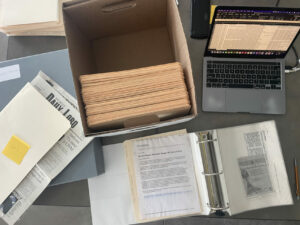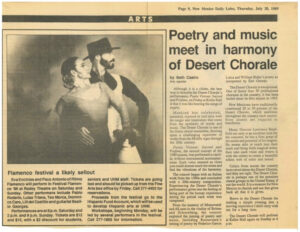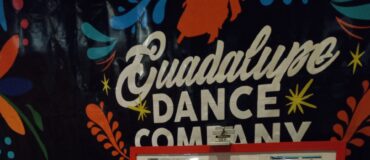By Amy Schofield
Amy Schofield is a 2024 Archiving and Preservation Fellow with the National Institute of Flamenco. Read more about the Fellowships here. This is the second part of Amy’s blog. Read the first part here.
System Creation & Magical Moments
For the past few weeks, I have been diving into the paper ephemera at the National Institute of Flamenco (NIF). When I arrived, I was excited to see that a lot of work had already been done in this area. I was given a three-inch white binder full of newspaper clippings, articles printed from the internet, programs from past performances, printed newsletters from the organization, and more, all spanning the years 2000-2010 and encased in plastic sheet protectors. This binder was accompanied by an external hard drive that contained digitized versions of these ephemera as well as an inventory spreadsheet.
“This is great! So much has already been done,” I thought…at first. When I explored this binder and the contents of the hard drive in more depth, however, I noticed a few issues. First, I knew I needed to rehouse the ephemera in folders and boxes rather than in sheet protectors that required larger newspaper clippings to be folded. Second, I noticed there was a disconnect between the physical ephemera and their digital versions. The individual paper materials in the plastic sheet protectors were not numbered, but they were physically arranged in chronological order. The files on the hard drive, on the other hand, were nestled in folders within folders. Labeled first by year, then by type (newspaper article, newspaper ad, program, flyer, etc.), the individual files within these folders were named with descriptive information about the item and arranged in alphabetical order. In other words, the inventory that I inherited could not serve as a finding aid, or way to match the digital and physical information.
I was able to locate the digital file from information on the physical item, but I could not easily locate the physical item from the inventory without flipping through large portions of the binder. I knew that these materials needed to be reprocessed and that the physical items needed to be connected with their digitized counterparts with a unique numbering system. As I rehoused the physical ephemera into folders, I kept them in chronological order as much as possible to save time, and the larger periodicals and newspaper clippings were set aside to be rehoused in larger archival quality newspaper boxes.

Periodicals and ephemera being processed.
After this process, it was time to make some decisions pertaining to the creation of a finding aid. As I mentioned in my previous blog post, NIF is a complex organization consisting of multiple overlapping branches. Most of the ephemera I was processing related to the Festival Flamenco Alburquerque*, the largest flamenco festival in the world outside of Spain. Next, a large portion of the ephemera related to the dance company founded in 2002, Yjastros: The American Flamenco Repertory Company. There were also many items that came from NIF’s various education branches, which includes the Conservatory of Flamenco Arts; Flamenco Kids Camp, which occurs in tandem with the festival every summer; the flamenco program within the Department of Theatre and Dance at the University of New Mexico (UNM); and Tierra Adentro, a middle and high school charter school opened in 2010.
As I went through these items, I made notes of the dates they spanned and large themes and connections between them. Also during this time, I met twice with my archiving mentor Irlanda Jacinto to discuss how to organize all the various materials so that they could be more accessible to both NIF staff and outside researchers who may utilize the collection. For the finding aid, we decided to create a “Periodicals and Ephemera” series with the following sub-series:
- Flamenco Festival
- Yjastros, Tablao Flamenco Albuquerque, and El Farol
- Education: Conservatory of Flamenco Arts, Tierra Adentro, UNM Dance, and Alma Flamenca
- Ritmo Flamenco
- Encinias Family
- Miscellaneous

Newspaper clipping from July 1989 promoting an upcoming performance by Ritmo Flamenco. Image courtesy of the National Institute of Flamenco.
As many members of Yjastros also perform at the local tablaos (flamenco performance venues), I included the postcards and advertisements for Tablao Flamenco Albuquerque and El Farol (in Santa Fe) within the “Yjastros” sub-series. Alma Flamenca was a performing troupe of Eva Encinias’s students from UNM. No longer active, I decided to include materials related to Alma Flamenca within the “Education” sub-series because of its connection to her work with the University. Ritmo Flamenco is another company that is no longer active. It was comprised of many local flamenco artists in the 1980s and 1990s, including Eva Encinias’s mother Clarita García de Aranda.
The “Periodicals and Ephemera” series also includes many newspaper and magazine articles that profile Clarita, Eva, Marisol, and Joaquin, or report various awards or recognition they have received from the city of Albuquerque and beyond. These items that are more closely tied to the Encinias family than to NIF are contained within the “Encinias Family” sub-series. Finally, a “Miscellaneous” sub-series houses items that stem from other local flamenco organizations and articles that describe the wider flamenco community in Albuquerque.

Stills from the video of Eva Encinias going through a box of photographs and newspaper clippings.
Among all this system creation, folder labeling, and spreadsheet creation, there were also a few truly magical moments. About a week ago, Eva found a box in her house that contained photographs and newspaper clippings dating back to the 1950s. I was excited to see what was inside and simultaneously stressed to suddenly acquire this new box of materials to be processed. Annie D’Orazio, NIF’s Operations Director, and I decided to go to Eva’s house and record a video of her going through these items with me. This provided invaluable information that I, alone, would never have been able to discern. It was incredible to watch Eva identify the people in each photo with such ease and remember the years and locations of performances from over forty years ago: “This was from the first time we went to Spain” or “Oh, that’s when we danced in the UNM Fiestas.”

Unprocessed photographs of the Encinias family.
Many of the photographs from that box have pinhole punctures in the corners, and Eva told us that they were once pinned to the walls of her mother’s dance studio. This means that many of the flamenco elders with whom we plan to conduct oral history interviews would be familiar with these images, having seen them covering the walls at every class and rehearsal. I am planning to save the task of processing these photographs until the end of my Fellowship because I want to use them in oral history interviews. I’m sure it will be special for the interviewees to see these photographs again and that they will spur detailed memories from their careers. But that’s a story for the next blog post!
*The festival purposefully uses the city’s original Spanish spelling. The extra “r” in “Alburquerque” is intended to connect the event Spanish heritage and flamenco in the city.
Header image: Eva Encinias with her company Ritmo Flamenco. Photo by Douglas Kent Hall.
All other photos courtesy of the author unless otherwise specified.

Amy Schofield (she/her) is a doctoral candidate in Dance Studies at The Ohio State University. She is a flamenco dancer, scholar, educator, and choreographer whose research explores the development and evolution of flamenco in the diaspora. Her dissertation analyzes the ways Latinx flamenco artists in the US can use their flamenco practice and performance as a decolonial praxis that mobilizes and reinterprets the percussive artform to reflect and serve Latinx communities. Amy holds an MFA in Dance from the University of New Mexico and a BFA in Dance from the University of the Arts (Philadelphia, PA). She has studied flamenco extensively in Spain and the US, and she regularly teaches and performs with U Will Dance Studio, The Flamenco Company of Columbus, and Caña Flamenca in Columbus, OH.
Photo credit: Elliot Archuleta
____
We accept submissions on topics relevant to the field: advocacy, artistic issues, arts policy, community building, development, employment, engagement, touring, and other topics that deal with the business of dance. We cannot publish criticism, single-company season announcements, and single-company or single artist profiles. Additionally, we welcome feedback on articles. If you have a topic that you would like to see addressed or feedback, please contact communications@danceusa.org.
Disclaimer: Opinions expressed in guest posts do not necessarily represent the viewpoints of Dance/USA.






